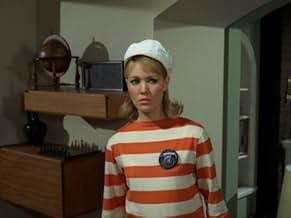Dopo le dimissioni, un agente segreto viene rapito e portato in quello che sembra un villaggio idilliaco, ma è davvero una prigione bizzarra.Dopo le dimissioni, un agente segreto viene rapito e portato in quello che sembra un villaggio idilliaco, ma è davvero una prigione bizzarra.Dopo le dimissioni, un agente segreto viene rapito e portato in quello che sembra un villaggio idilliaco, ma è davvero una prigione bizzarra.
- Premi
- 1 vittoria e 1 candidatura
Sfoglia gli episodi
Trama
Lo sapevi?
- QuizThe Prisoner was filmed in the North Wales resort village of Portmeirion over the course of a year. Patrick McGoohan was inspired to film his series there after filming a couple of Danger Man (1960) episodes in the village.
- BlooperIn the opening sequence, the letter X is typed across the prisoner's photograph, but the typewriter typebar for the letter H is moving. The typebar for the letter X is at the far right of the frame.
- Curiosità sui creditiPortmeirion, Wales is not identified as the location for filming in all but the final episode. Instead the closing credits in these episodes simply say "Filmed on location."
- Versioni alternativeIn the recent re-run of the series on the Horror channel in the U.K. whenever anyone is attacked by Rover, the screen simply changes to a swirling vortex. When shown originally, the victim's face was pressed into Rover's 'skin'
- ConnessioniEdited into Derrick contre Superman (1992)
Recensione in evidenza
The best non-comedic TV show I've ever seen, and certainly one of the most unique TV shows of any genre. A terrific blend of Kafka's drama/satire, fantasy, and spy action/thriller. There is also a healthy dose of humour in it, but nothing over-the-top like we have in today's TV shows. Although it consists of 17 episodes, I would consider the first 12 to be the core of the series. After those 12 we have mostly filler episodes, like the dull one in the Wild West, or the one in which McGoohan barely even appears. The last two episodes, the less-than-grand double-episode finale, are a bit too abstract and quite tiresome at times even. From the last 5 episodes I would only name "The Girl Who Was Death" as being quite good.
The best/most fun episodes are "Arrival", "Dance of the Dead", "ABC", "The General", "A Change Of Mind", and "Hammer Into Anvil". From the first 12, I would only single out "Schizoid Man" as being much weaker than the others.
Several things went into making this show so much fun. First of all, the location, the Welsh village. Secondly, having McGoohan in the lead; I cannot possible imagine any other actor playing Number 6 in the excellent, off-the-wall yet controlled manner in which he plays him. McGoohan hits all the right notes; his performance is just as eccentric as it needs to be. (For the uninitiated, he was among the 2 or 3 main candidates to be the first James Bond, but refused the role.) Thirdly, the highly unusual, original scripts. Fourthly, the series was filmed in the mid-60s, and the visual quality of TV shows from that decade is superior to anything that came before or after. And fifthly, the acting from all the others was on a high level.
The best/most fun episodes are "Arrival", "Dance of the Dead", "ABC", "The General", "A Change Of Mind", and "Hammer Into Anvil". From the first 12, I would only single out "Schizoid Man" as being much weaker than the others.
Several things went into making this show so much fun. First of all, the location, the Welsh village. Secondly, having McGoohan in the lead; I cannot possible imagine any other actor playing Number 6 in the excellent, off-the-wall yet controlled manner in which he plays him. McGoohan hits all the right notes; his performance is just as eccentric as it needs to be. (For the uninitiated, he was among the 2 or 3 main candidates to be the first James Bond, but refused the role.) Thirdly, the highly unusual, original scripts. Fourthly, the series was filmed in the mid-60s, and the visual quality of TV shows from that decade is superior to anything that came before or after. And fifthly, the acting from all the others was on a high level.
I più visti
Accedi per valutare e creare un elenco di titoli salvati per ottenere consigli personalizzati
Dettagli
- Data di uscita
- Paese di origine
- Lingua
- Celebre anche come
- The Prisoner
- Luoghi delle riprese
- Abingdon Street, Londra, Inghilterra, Regno Unito(underground carpark in title sequence)
- Aziende produttrici
- Vedi altri crediti dell’azienda su IMDbPro
Contribuisci a questa pagina
Suggerisci una modifica o aggiungi i contenuti mancanti

Divario superiore
What was the official certification given to Il prigioniero (1967) in Canada?
Rispondi



































